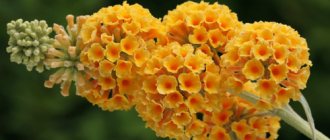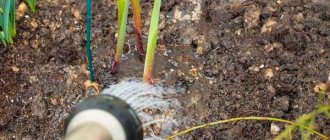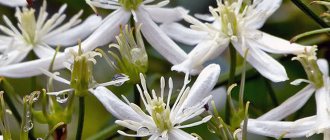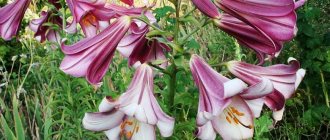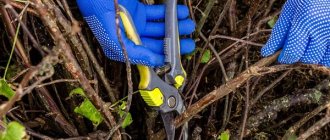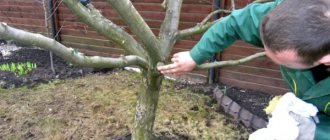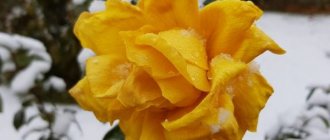Planting and caring for buddleia in the Moscow region differs from agricultural practices in the southern regions. The plant enters the flowering phase in the fall and remains decorative until the first frost. In warm climates, winter preparation work is minimal. To preserve the root system in a temperate climate, the crop requires a number of additional measures.
Frost-resistant buddleia varieties
Budleya is called the “eastern beauty” for a reason. Countries of warm latitudes are considered its homeland, so it is not surprising that the plant feels most comfortable in the southern regions. However, growing budleya in a summer cottage in the Russian climate is also quite possible with proper care and attention.
Since buddleia has gained popularity far beyond the subtropical zone, breeders regularly develop new varieties that can please the eyes of those who live in less hospitable climates.
The most frost-resistant plant varieties include:
- David's buddleia, in particular the Empire Blue, White Profison, Pink Delight and Royal Red varieties;
- Budleyu Wicha;
- Budley Wilson.
They are able to withstand frosts down to -23 °C.
In addition, among the variety of species, representatives with average winter hardiness are distinguished, including:
- Budleya japonica;
- White-flowered buddleia.
Propagation of buddleia by cuttings in autumn
People who have previously dealt with growing buddleia know that it reproduces intensively both by cuttings and by seeds. However, in the Russian climate, even with proper care, it is not always possible to grow buddleia with seeds, and therefore the second breeding option is common in this area.
For cuttings of buddleia, planting material is prepared in the fall, during the autumn pruning of the bush. Cuttings are best made from one-year-old plant branches, cutting them at an angle of 45°.
Planting of cuttings is carried out with the onset of spring or in the autumn months after pruning is completed.
Autumn planting is carried out according to the following algorithm:
- Shrub cuttings are placed for 5 - 10 hours in a solution of Kornevin or Heteroauxin.
- Make holes in the loose soil and water them generously.
- Then the buddleia shoots are placed 3 - 4 cm inside. The distance between them should be 1.5 - 2 m.
- After this, the plant cuttings are covered with plastic bottles wrapped in polyethylene and left until spring.
Fragrant boiled pork in foil with carrots
Cooking time – 10-12 hours with marinating.
Servings – 6-8 pcs.
Baked pork is not only an ideal meat for a holiday table, but also for everyday sandwiches: meat baked at home in the oven is an excellent substitute for any sausage. In addition, homemade boiled pork is much healthier than store-bought meat, as it does not contain harmful preservatives or food additives. The recipe for making homemade boiled pork from beef is simple: the secret to the success of the finished dish lies in proper marinating of the meat.
Ingredients Servings: –+6
- Beef tenderloin 1 kg
- Garlic 1 head
- Carrots 2 pcs.
- Pork lard 150 gr. (optional)
- Vegetable oil 60 ml.
- French mustard 4 tbsp.
- Black peppercorns 5 pcs.
- Allspice 5 pcs.
- Bay leaf 3 pcs.
- Salt - to taste
- Ground black pepper - to taste
- Seasoning for meat - optional
Steps 10 min.Print
- To prepare aromatic, juicy and tender boiled beef, you need to soak the meat well in the marinade. Therefore, take the time and marinate the beef for 4-6 hours or overnight. To prepare the marinade, pour about 1 liter of water into a deep saucepan, add bay leaf, black and allspice peas and salt. Boil the marinade and cook for 2-3 minutes, cool. Dip the meat into the marinade: it should cover all the beef, so the amount of water can be increased slightly.
- When the meat is marinated, wash and peel the vegetables: carrots and garlic. Cut the garlic cloves into several pieces. Cut the carrots into medium cubes.
- If you want your boiled beef to be juicier and less lean, add a piece of fresh lard to it. Cut the lard into small cubes.
- In a bowl, prepare a coating for meat: mix mustard grains, salt, ground black pepper, meat seasoning and vegetable oil.
- Using a thin and sharp knife, make “pockets” in the meat on all sides, where you place garlic cloves, lard sticks and carrots.
- Rub the stuffed meat thoroughly on all sides with a coating and place it in a fireproof form.
- Cover the dish with the meat with foil and marinate in the refrigerator for another 2-3 hours. Then place the pan with the meat in a cold oven. Set the temperature to 180-190 degrees. Bake the meat for 1.5-2 hours.
- To ensure that the boiled pork gets a beautiful crust, 15 minutes before the end of cooking, remove the foil and bake the meat without it. After 1.5 hours, pierce the meat with a thin knife - if the juice is pink, it means the meat still needs to be cooked, and if it’s clear, the meat is ready. Remove the finished beef from the oven, let cool slightly and cut into portions. Eat your deli meat hot or cold.
Bon appetit!
Tip: To make the best roast pork, choose the freshest beef cut possible. It should not be frozen, but chilled. Meat that is too old and dry is not suitable for this purpose.
How to plant budleya in the fall
Planting buddleia in open ground in the fall is not much different from the same process in the spring. In the autumn, the choice of seating must be approached with special care, giving preference to sunny areas protected from drafts. It is best to carry out autumn planting on a sunny, dry day at a temperature not lower than +10 °C.
The type of soil is not particularly important for the plant; it can grow in almost any area. The main thing is that the soil is not excessively wet, otherwise the root system will begin to rot.
Having decided on the location, you can start planting “autumn lilacs”:
- First, dig a hole 30 - 40 cm deep. The width should be 2 times the diameter of the buddleia rhizomes.
- Then a 10-15 cm layer of high-quality drainage is laid at the bottom of the recess. Peat, shavings or charcoal are suitable for these purposes.
- A layer of organic subcrust, for example, compost mixed with ash, is placed on top of the drainage material.
- Next, half of the previously prepared soil is poured into the hole.
- The plant is dug up along with a lump of earth, making sure that the roots are not exposed.
- Carefully move the buddleia to the chosen location.
- Add the remaining soil.
- After this, the soil is compacted. If during the autumn period no cold or precipitation is expected in the next 2 weeks, then the tree trunk circle of the bush is watered abundantly.
Important! In autumn, you need to pay close attention to the depth of planting of shrubs. It should be dug down so that its root collar is at the same level as the soil.
If you plant budleya in the fall according to all the rules and organize proper care for it, then it will have time to take root before frost hits. However, the chances of success will be much higher in those regions where temperature changes are not extreme. But even in this case, it is worth remembering that planting in the fall is quite traumatic for the plant, and it should not be done unless absolutely necessary.
Replanting buddleia in the fall
Despite the fact that buddleia is quite unpretentious in care, this plant is difficult to tolerate transplants, since its tap root is located deep in the ground, and its removal can injure the root system of the bush. However, sooner or later it may be necessary to transplant the buddleia to a new place, and the optimal time for this is the spring before the start of the growing season, when the risk of sudden frosts is minimal and the soil is sufficiently warm.
In the fall, budleya is replanted only in extreme cases. At this time, the chances that the plant will take root are very low, even with proper care. If you transplant it into open ground in the fall, there is a high probability that the shrub will not survive the winter months, since it simply will not have time to gain a foothold in the new area. Therefore, if possible, it is worth postponing the procedure until a more appropriate time. If autumn replanting of buddleia is inevitable, the plant should be provided with proper care for a successful wintering.
Proper planting of plants in open ground
If you want to plant a buddleia from a cutting, then you should know:
- It should be planted only when the earth warms up. The best period is the end of April-May. Since the plant is not yet very strong, it is worth placing some mineral fertilizers in the soil. It is worth considering that a lot of moisture is not needed at all. In spring there is a lot of rain. Do not flood the plant under any circumstances. But you should not leave the landing site dry, as the budleya may not take root.
- As for adult bushes, this does not require any knowledge at all. The only rule is spring planting time.
These shrubs are completely unpretentious, which is why they are called wild-growing. But in order for the buddleia to grow better, before planting, choose a more spacious place for it, or a place near the fence, which it will perfectly decorate, will suit it.
Choosing a location and preparing the soil
- Budleya loves the sun, but not too much. The ideal option for her would be a place with a little shade. Planting it behind the house or near the fence will be just right. But if you have a spacious place where the soil is not exposed to much direct rays, you made the right choice.
- More space is one of the most important issues for planting. This shrub loves freedom so much that it is ready to grow as wide as possible, just give it a reason. So, if you have a lot of free space, feel free to plant Budleya there.
Over the entire winter, the earth was very depleted, and there were absolutely no useful substances left in it. The soil needs to be fertilized for several days so that as many nutrients as possible are absorbed. Remember, if you plant buddleia from cuttings or from seeds, fertilizing is required, since the plant is very weak and requires a lot of feeding.
How to care for buddleia in the fall
In the fall, subsequent care of the transplanted buddleia is not too complicated and comes down to mulching and pruning.
Many gardeners are interested in the question of whether it is worth including watering and fertilizing in the buddleia care procedures before sending the plant for the winter. This largely depends on weather conditions.
It is worth watering the plant in the fall when the weather is dry and sunny and only if the soil near the buddleia bush is completely dry. Before doing this, you need to dig a ditch around it and water it using settled water at room temperature. The ditch should not be made very deep, since the roots of the buddleia lie close to the surface of the soil. This method of autumn watering will help the buddleia rhizomes absorb more water.
As for feeding buddleia, according to the care recommendations, it is not advisable to carry it out in the autumn season. This way the crop will overwinter better in open ground. On the other hand, fertilizing applied to the hole during planting will not cause further harm.
This method of care, such as mulching in the fall, will also help prepare the buddleia for the winter. An air space is created between the soil and the mulch layer, which keeps the roots from freezing in winter and ensures optimal heat exchange for the shrub. Buddleians use peat, rotted manure or straw as mulch. Autumn mulching is carried out immediately before covering the plant.
How to choose meat for boiled pork
Venus Flytrap care at home what to feed wintering
Baked pork is a piece of non-wiry, not very fatty marinated meat, baked with spices. Traditionally, boiled pork is made from pork. Ham is best suited for this dish - it has very tender meat and a small layer of fat, which will make the dish even more juicy. Fans of less fatty dishes use neck meat for baking. If we move away from the classic version of baked meat, beef, veal or turkey are also used to prepare boiled pork.
To prepare delicious juicy boiled pork, when choosing meat you must adhere to three main criteria
- Color. Fresh meat should be pink or light red in color. Grayish tints indicate that the product has been sitting on the counter for a long time.
- Smell. Fresh meat has a sweetish smell, while spoiled meat has the smell of rotten flesh.
- Texture. Fresh meat should be dense and elastic, and the surface should not stick to your hands.
There is another way to determine the quality of meat, but this can only be done at home. So, take a small piece of meat and pour boiling water over it. After five minutes, look at the water. If it is cloudy and small rags are floating in it, the product is not of high quality; if the water is clean and transparent, with small splashes of fat, everything is in order, the dish will turn out tasty and healthy.
How to prune buddleya for the winter
Pruning buddleia is another important point in caring for shrubs. Often this procedure refers to spring pruning, which precedes the growing season. However, buddleia is also pruned in the fall, before sending it for the winter. This method of care is not aimed at giving the plant an aesthetic appearance, but has a practical goal - to make life easier in late autumn and winter.
Do I need to prune buddleia for the winter?
Being a crop of tropical origin, buddleia is quite sensitive to low temperatures. Even frost-resistant varieties, such as Buddleia Davida, often have problems withstanding the Russian cold and require special preparation for winter. The ability to properly prune a bush in the fall affects how the plant will subsequently be covered and whether it will be able to quickly wake up from wintering with the onset of warmth. Therefore, in temperate latitudes, pruning of buddleia in the fall is mandatory.
Preparation of tools and materials
The procedure for pruning buddleia in the fall does not require the purchase of any special tools. To do this, a standard plant care kit, which every gardener can find, will be sufficient. It includes:
- pruning shears for plant branches 25 mm thick;
- gloves;
- protective glasses.
If pruning in the fall is carried out on tree-like varieties of buddleia, then it would not be a bad idea to get hold of a stepladder and a lopper. The latter will help in removing thick branches up to 5 cm in hard-to-reach places in the “autumn lilac” crown.
Timing of pruning
Experienced plant growers who know a lot about caring for buddleia recommend pruning the bush in the second half of autumn, as soon as its leaf blades begin to turn black. The timing of autumn pruning is influenced by the climatic conditions in the region and what care the buddleia received during the season. As a rule, this procedure occurs at the end of October - beginning of November.
How to prune buddleia for the winter
Autumn pruning of buddleia does not require special skills and effort, however, when starting the procedure, you should take into account the area where the crop is grown and its variety. So, when pruning David's buddleia in the fall in areas with a climate close to the subtropics, you only need to shorten the branches by 5 - 10 cm. This will be enough for the plant to survive until spring. And even if in the event of a sudden cold snap the above-ground part of the buddleia freezes, the bush will quickly send out young shoots as soon as favorable weather sets in.
In other climatic zones, they practice autumn pruning of buddleia under the stump, leaving only 20 cm cuttings above the ground. In this form, it will be easier to cover the plant, and it will not suffer from frost.
Advice! Pruning in the fall is the right time to prepare material for propagation of buddleia.
Caring for the crop after pruning
Once the autumn pruning is completed, the buddleia does not require any further care until the next summer season. All that remains to be done is to clear the area around the bush of debris and take care of creating a shelter.
Growing and care
In its homeland, the shrub grows up to 5 meters in height; in our conditions, it rarely reaches a height above 2.5 m. Buddleia David has a very long growing season. Its shoots develop before the first frost, but a very cold winter can destroy them. The bush is susceptible to freezing, so it needs to be protected for the winter and find a suitable place in the garden.
Buddleia is rarely grown as a houseplant - it is a vigorous bush after all, but due to its low frost hardiness, some people choose to grow it in containers. For small specimens this is a good solution - for the winter you can put the container in an unheated garage or other bright room, but large specimens should be planted in the ground. These are not your typical houseplants, and growing buddleia this way does not always produce the desired results.
We suggest you familiarize yourself with How to store lemon so that it does not spoil: in the refrigerator or freezer
Trimming
An important care procedure is pruning buddleia. It must be performed annually. The plant needs rejuvenating pruning to bloom profusely and beautifully. Reception is divided into 2 types:
- Sanitary pruning of buddleia is carried out in early spring. Remove frozen shoots and branches that are damaged after winter.
- Rejuvenation is also carried out in the spring. The plant recovers quickly. Even if you shorten it to 20 cm above the ground, in the same year the shoots will grow and bloom, and in the season the bush will reach its normal height.
Pruning will help prolong flowering and the flowers will remain on the plant throughout the season. The procedure is very simple even for novice gardeners. Even an incorrectly pruned bush will not deprive us of flowers this season.
Photo. The bush requires severe pruning of all shoots in early spring
- All last year's shoots are cut low at the same height: above 1-2 pairs of well-developed, healthy eyes. If it is necessary for the bush to remain taller, it is pruned above 3-4 pairs of eyes.
- Remove all unnecessary shoots - diseased, damaged, intersecting branches that excessively compact the bush.
Some useful pruning tips:
- The branches can be thick and hard, a regular small pruner may not be able to cut it and you may need a large one or a pruning saw.
- You need to cut diagonally so that water does not get on the remaining buds. This can cause fungal diseases.
- Pruning is performed on a frost-free sunny day using clean, sharpened tools.
- Woody shoots of larger diameter (more than 1 cm) are recommended to be lubricated with garden ointment and fungicide to reduce the risk of infection.
Photo. Buddleia bush pruned in spring with a hedgehog
Photo. This is what a buddleia bush looks like in summer, pruned in spring to a height of 10 cm
It is necessary to regularly remove faded inflorescences, and new ones will appear on new side shoots. The bush will be full of flowers until late autumn. If you remove faded inflorescences, the plant does not waste energy on setting and growing seeds, of which it produces a huge number.
Photo. Faded inflorescence with fruits - seeds
Reproduction
Budleya reproduces easily. The bush is very well accepted and develops well from cut stems - cuttings. You can cut cuttings from:
- semi-lignified shoots - they are cut in the second half of summer;
- woody ones - cut in autumn or early spring.
The cuttings are placed in water or moist soil to take root. It is advisable to cover the box with cuttings with film, periodically airing it. Rooting is successful in most cases. When the seedlings begin to grow, you can plant them in a permanent place in the garden.
Photo. Buddleia seedlings.
Buddleia Davida seeds are sold in stores. Germination rate is about 40%. They require stratification and light to germinate. Germination of buddleia planted from seeds at home takes a long time (up to 4 months) and is not uniform. Therefore, it is preferable to propagate buddleia not by seeds, but by cuttings.
Regardless of propagation method, new plants should spend their first winter in a cold room. It may be a dark room, but the temperature should not rise above 2-3 °C. If the temperature is higher, the plant receives a signal that it is time to start growing. Then the room should be bright. Young plants are planted in the ground when there is confidence that spring frosts will not return.
Watering and fertilizing
Buddleia is a shrub that requires care and attention. These are large and fast-growing plants with large leaves. They need enough nutrients and water - the leaves transpire a lot and consume a lot of minerals during photosynthesis.
The shrub needs quite a lot of water, especially young seedlings. During periods of drought or prolonged lack of precipitation, it is necessary to systematically moisten the soil.
Caring for buddleia requires some financial costs for specialized fertilizers. The soil around the bush should be fertilized periodically. Buddleia is fed 3-4 times a season with a high dose of complex mineral compounds. The plant is especially demanding of feeding during flowering, when it consumes a lot of nutrients - minerals in the soil must be regularly replenished.
On light, permeable soils, regular watering will be required in summer, despite the plant's rather deep roots. Especially on such soils, in addition to the spring dose of fertilizer, it is important to feed before flowering. For feeding, it is better to use fertilizer for tomatoes than azofoska. Nitrogen in azophoska or polyphoska will reduce the intensity of flowering.
Buddleias are sensitive to cold. This capricious bush does not tolerate low temperatures. Planting and caring for buddleia in Siberia and the Urals require increased attention. With proper protection, the plant will be reborn in the spring. The bush has an extraordinary ability to produce new shoots, even if you have to cut off all the old, frozen branches, you can expect abundant flowering in the same year. However, it is necessary to protect its root system and the “base of the bush” by all means.
For this purpose, a hill is poured around the bush, similar to covering rose bushes. For the embankment you can use:
- soil,
- compost,
- pine bark,
- agrofibre.
Bark coverage may not be sufficient. The standard mound height of 30 cm is too small on old bushes. It's better to use a lot of compost.
Pre-pruned and tied buddleia bushes can be covered with winter agrofibre (P50) before frosts. After fixing it, the base is sprinkled with soil.
The plant can also be wrapped in a hood made of agrofibre or jute fabric (burlap) - this will be excellent protection from the wind. Some gardeners also put straw protection on the bush. Protecting the base of the shoots is very important, especially in snowless winters. Buddleia has a better chance of surviving the cold under a fluffy blanket of snow.
In spring you need to remove the cover. It is better to take your time so that late frosts do not destroy the shoots.
Diseases, pests
Buddleya, according to reviews from summer residents, almost never gets sick. In spring, aphids can settle on young shoots and suck the juices, deforming the young leaves. It is necessary to immediately treat the bush with an insecticide.
Hot, dry summers favor spider mites. Initially, it appears only on the lower leaves (light spots are noted on the underside). Yellowed leaves fall off. Ticks require spraying with an acaricide.
How to cover a Budleya for the winter
Since most types of buddleia are heat-loving, winter is a very harsh time for such shrubs. How the plant is prepared for winter directly determines its well-being and further flowering.
Tender young shrubs that have not reached 2–3 years of age especially suffer from temperature changes, since they are most likely to freeze in the area of the lower branches. But if temperature indicators do not fall below 5 - 10 ° C, then there is a possibility that with the arrival of spring, young buddleia will recover quite quickly. In severe frosts, the shoots will have difficulty growing green mass and will bloom weakly.
To avoid this and ensure your buddleia have a successful winter, you should take care of proper care for them in the fall by building a shelter from frost:
- First, a special frame about 20-25 cm long is made. It can be made of wood or wire mesh.
- Then it is wrapped in waterproof fabric or other waterproof material, for example, polyethylene or roofing felt.
- After this, the frame is carefully fixed with stones on all sides so that it does not blow away by the wind.
- Dry leaves or hay are placed inside the structure. To cover buddleia in a climate with slushy autumns and mild winters, you should never use film or sawdust, otherwise the bush will be locked under such cover.
Advice! The frame for a buddleia should be as wide as possible - thus, the shelter will provide the bush with a large amount of warm air, which it needs to feel better.
Preparing meat for roasting
Schisandra chinensis planting and care in the Moscow region
Rinse the meat well under cold water and dry with a paper towel. If a piece of meat is too fatty for you, simply skim off the excess fat on top, leaving about 0.5 centimeters. Trim, if any, the chaff and small thin pieces according edges. Remove the chaff carefully so that the boiled pork does not end up looking cut up and ugly. The meat is ready for marinating.
Before baking, the future boiled pork is marinated and stuffed. To do this, they use different methods and ingredients - mustard, vinegar, lemon, pepper, herbs and much more. But there is a main rule - for boiled pork to be juicy, it needs to be marinated for 10-12 hours. If it is less, it will not have time to absorb the required amount of marinade; if it is more, it will give up its juice to the marinade and will be dry.
Advice: when working with meat, constantly stroke it, giving it the desired shape so that it remembers it, and the boiled pork subsequently has a beautiful appearance.
This is interesting! Previously, meat was marinated by sticking it in an anthill. Formic acid softened its hard structure; the main thing was to make sure that the ants did not eat the delicacy completely.
When the meat is well marinated, remove excess marinade from its surface - most of the mustard or peppercorns so that it all does not burn.
Before baking, brown the meat on all sides. Just a little, just so that a thin crust forms and the juice remains inside during baking. To do this, you need to heat the pan well and fry each side for about 20 seconds. Oil is not needed for frying; this must be done in a dry frying pan.
Features of preparing buddleia in the fall for winter in the regions
Often, the nuances of how to prepare a budlea for the winter become clear when analyzing the characteristics of the region in which the shrub is to be grown. Each area has its own nuances for plant care.
In outskirts of Moscow
So, in the Moscow region, where the winter months are relatively warm but characterized by humidity and unstable precipitation, gardeners make improvised greenhouses from polyethylene. The method for constructing this structure is described above. Often, this measure is sufficient for the well-being of the plant.
Important! Even with proper care, some buddleias die in such a climate after reaching 4-5 years, since their winter hardiness decreases with age. Based on this, in order for the shrub to please the eye with large, bright flowers, it must be regularly updated.
In the middle zone
In the climate of central Russia, it is imperative to make the most protected shelters during autumn frosts and winter cold. Under these conditions, buddleia grown from the seeds of shrubs that grew here and not in warm regions overwinters most successfully.
In Siberia and the Urals
Before wintering, buddleias in the Urals and Siberia mulch covered shrubs with sawdust. This method successfully protects the plant from freezing, but the effectiveness of the method only applies to these areas. In warm regions, wood shavings can only destroy the buddleia, as it interferes with the circulation of moisture in the soil and can lead to bud rot.
Important! In Siberia, the shelter from buddleia is removed only when the air reaches a temperature of +10 °C and the threat of spring frosts has passed.
In the Volga region
In the Volga region, buddleias are often grown as a tub crop, and during wintering the tubs with the plant are moved to a basement or other frost-free place.
If the shrubs are still grown in open ground, then in the fall a film greenhouse is built for them, in which a dense layer of mulch is laid, or a box is installed, on top of which spruce branches are laid out.
Soil and fertilizing
Moistening the soil around the buddleia should only be done in drought and hot weather.
It is necessary to moisten the soil around the plant only in very hot, dry weather with the following calculation: one bucket of settled water per bush. The result of good care and feeding will be abundant and long flowering, the inflorescences will grow large and beautiful. For fertilizer, it is better to use alternating mineral fertilizers with liquid ones, and apply fertilizers containing potassium and phosphorus two to three times a year. The root system of buddleia is horizontal, it does not tolerate weeds, so the soil needs to be cultivated, loosened and kept clean from time to time.
The rotted layer of soil must be changed at least once every two years. The plant really likes watering with a cow dung solution. First you need to dilute 2 liters of manure, fermented for 14-16 days, with 1 liter of water. At the next stage, dilute the resulting solution with water again: 200 ml of solution per 1 liter of water. Feeding with ash from July to September (before flowering) is also useful. Additional fertilizers will make the bush lush and beautiful, and in place of one faded inflorescence, two new ones will immediately appear.
Therefore, it is important to remove old, reddish “panicles” in a timely manner so as not to spoil the overall appearance
Pruning buddleia is a very important element of caring for this plant. With age, it loses its shape, and old branches sticking out in different directions make the bush unattractive. In the spring, when the weather becomes warm, you can prune, following these rules: cut short varieties at least 30 cm, and tall ones - up to 90 cm. This type of care also stimulates abundant flowering.
Budleya is quite resistant to various types of garden pests. It can only be affected by whiteflies or spider mites, and then only in very dry weather. In this case, the diseased stems must be carefully removed and the bush treated with special medicinal solutions.
For propagation, you can collect buddleia seeds after flowering. But it is still better to select this bush using cuttings.
After flowering, young shoots of the same year should be cut off and left for the winter in a dark, cool, but not frosty place, and planted in the ground in the spring. During planting, two of the three buds should be buried in the ground for rooting, and the third should be left above the ground for young leaves.
An unusually beautiful buddleia plant is worth the effort. The shrub will decorate any garden, summer cottage or open terrace. For a skilled gardener or landscape designer, it will be a real find.
How to preserve buddleya in winter
Often, when caring for buddleia, even experienced gardeners encounter difficulties due to the fact that the plant is reluctant to emerge from its winter dormancy and begins to grow greenery only in the fall. In some cases, the bush freezes completely. You won’t be able to completely insure your plant against this problem, but you can reduce the risk if you follow simple winter care recommendations:
- At the age of 1 - 2 years, even the most winter-hardy species, such as Wicha's buddleia or David's buddleia, are moved to a pot for the winter and placed in a dark, well-ventilated room or basement. The air temperature should not exceed 10 – 12 °C. In this form, the shrub will overwinter without any problems in the absence of watering and light, and in April it can be transplanted to a permanent place.
- The last feeding of buddleia should be carried out no later than the beginning of autumn: best in June-August.
- All plants in areas where the thermometer drops below -5 °C are subject to shelter. If there is no need for more complex structures, you can protect the bush with spruce branches or brushwood. Snow is also great for covering.
- It is better not to use sawdust and autumn leaves to protect buddleia from the cold. This material retains water and does not allow air to circulate, which can cause the plant to shut down.
- Before constructing the protection, the buddleia shrub is hilled to the height of the 3rd bud on the remaining stem. The soil used for the procedure must be dry.
If you follow these care rules, the plant will easily survive the autumn cold spells and the most severe cold.
Important! Flower growers who have been caring for Buddleia for many years claim that plants grown from locally packaged seeds overwinter more successfully than purchased seedlings.
The most popular varieties for the Moscow region that tolerate frost well
Of the 160 varieties of shrubs, buddleia alternate-leaved, David, Wich, Wilson, as well as Belotsvetkovaya and Snezhnaya were acclimatized in Russia.
David
Budleya David in the conditions of the Moscow region and the Urals grows up to 2-3 m . It has large two-color leaves up to 20 cm in length and spike-shaped inflorescences (up to 40 cm).
The flowers are lilac in color and smell of honey. Flowering period from late July to September. It has varieties that differ in flower color:
- Alba, White Cloud, White Proffusion - white;
- Empire Blue, Black Knight - purple tones;
- Harlequin, Royal Red - red shades.
Wilson
Budleya Wilson resembles a weeping willow. It blooms from mid-August to the end of September with lilac-pink inflorescences up to 75 cm.
Wilson
Vicha
Budleya Vicha blooms in early August with large, rich pink inflorescences.
White-flowered
The Buddleia Belotsvetkova bush has pyramidal vertical inflorescences with small white flowers.
White-flowered
Snezhnaya
In Buddleia Snowy, the leaves, branches and flowers are covered with tiny dense hairs that resemble felt. Lilac inflorescences are small, paniculate.
The heat- and light-loving plant can be grown in conditions of low winter temperatures and recurrent frosts. The strong annual growth of shoots compensates for the freezing of the bush in winter.
Snezhnaya
Proper planting and care, timely pruning and covering for the winter will create the proper conditions for the growth and flowering of buddleia.
This is a guest from China in our areas, which is often called “autumn lilac.” The plant is spectacular and I want to preserve it in the winter so that I can admire the flowering next season. Good news for gardeners is the fact that it is quite easy to preserve budlea in winter, since in warm regions it survives this time well even without shelter. But even with such excellent indicators, the plant will have to be prepared somewhat.
Pruning buddleia for the winter
If you live in a warm climate, you won’t be able to do without pruning. The important thing here is not just to make the cuts correctly. The fact is that the success of wintering is also influenced by the correctness of planting the bush initially. The three-year-old bush should reach its permanent place in April-May. Younger bushes overwinter in tubs with soil in the basement.
Around the end of June, potassium-phosphorus fertilizers are applied to the bush. As soon as blackening of the foliage is noticed on the bush, it should be cut off at a distance of about 20 cm from the ground. Adult buddleia bushes begin to be prepared for winter in October after pruning has been done almost to the root: the plantings are thoroughly watered and then earthed up every other day.
How to cover a Budleya for the winter?
Next, let's move on to a more detailed consideration of the issue of how to cover budleya for the winter. We will also dwell on some controversial points. After pruning, the bushes are spudded using one of the methods that we will consider below. And then opinions differ. Gardeners use three main methods of preparing buddleia for winter:
- All are equally spudded only with dry soil. Next, there is the option of using boxes, which will then be covered with a layer of snow. Instead of wooden boxes, you can safely use pieces of slate or similar material. Your goal is to create an air gap between the soil embankment and the snow. The fact is that even such a shelter does not guarantee a successful winter for the bush. Young plants and ornamental varieties are afraid of spring frosts. A warm winter can also be dangerous, when at first there is a lot of snow, then it begins to melt. This will lead to wet soil and rotting of the bush buds in the shelter.
- That is why there is a different opinion regarding the care of buddleia for the winter. The pruning scheme and the principle of hilling are no different. But instead of slate or boxes, some gardeners prefer to use iron arches. A film or spunbond or other covering material is stretched over these arcs, and snow falls on top of it. You will get something vaguely similar to a greenhouse. For the middle zone, the height of the arcs reaches approximately 30 cm, and for colder regions it is up to 40 cm. In this way, we obtain a large air gap and retain heat for the plant.
- There is a third option for preparing buddleia for winter, but it is only suitable for the coldest regions. The idea is that after pruning and watering, you do not need to cover the bush with soil, but use sawdust. We simply pour about a bag of sawdust onto the prepared bush, and in mid-May the sawdust is removed and the plant successfully begins to grow. But this method is only for cold regions, since in warm climates sawdust contributes to the accumulation of moisture and rotting of the buds.
Thus, caring for buddleia for the winter comes down to four main stages. First we feed the plant, then we prune it properly and water it. Next, we should choose the type of hilling (sawdust or soil) and the method of covering. It's difficult to say what exactly will be the ideal solution for you, but the goal remains the same: to prevent overheating. And this is achieved by the correct height of the embankment and the size of the air cushion. And by the way, a plant grown from seeds adapts to cold weather much better and overwinters without loss.
We tell you how to prepare buddleia for winter quickly and easily. Recently, the shrub has become increasingly popular among our gardeners and not only in the south.
The popularity of buddleia is hampered by its low winter hardiness; in our climatic conditions, it often freezes out in winter.
